Isao Echizen
DRAGON: A Large-Scale Dataset of Realistic Images Generated by Diffusion Models
May 16, 2025Abstract:The remarkable ease of use of diffusion models for image generation has led to a proliferation of synthetic content online. While these models are often employed for legitimate purposes, they are also used to generate fake images that support misinformation and hate speech. Consequently, it is crucial to develop robust tools capable of detecting whether an image has been generated by such models. Many current detection methods, however, require large volumes of sample images for training. Unfortunately, due to the rapid evolution of the field, existing datasets often cover only a limited range of models and quickly become outdated. In this work, we introduce DRAGON, a comprehensive dataset comprising images from 25 diffusion models, spanning both recent advancements and older, well-established architectures. The dataset contains a broad variety of images representing diverse subjects. To enhance image realism, we propose a simple yet effective pipeline that leverages a large language model to expand input prompts, thereby generating more diverse and higher-quality outputs, as evidenced by improvements in standard quality metrics. The dataset is provided in multiple sizes (ranging from extra-small to extra-large) to accomodate different research scenarios. DRAGON is designed to support the forensic community in developing and evaluating detection and attribution techniques for synthetic content. Additionally, the dataset is accompanied by a dedicated test set, intended to serve as a benchmark for assessing the performance of newly developed methods.
Diffusion-Driven Universal Model Inversion Attack for Face Recognition
Apr 25, 2025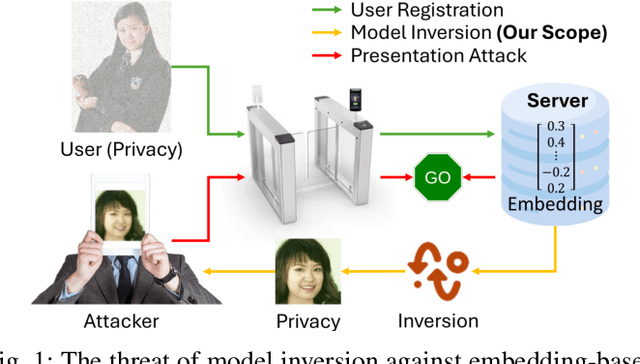

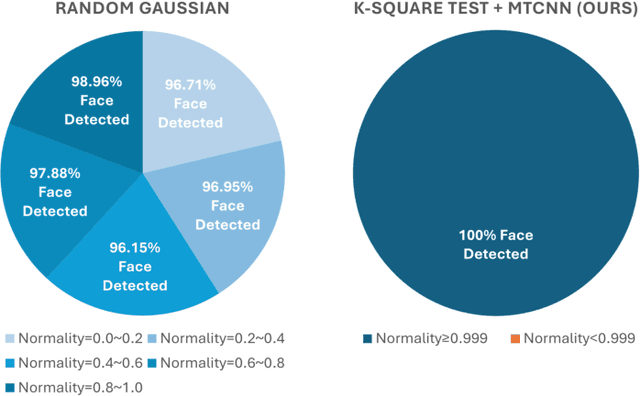
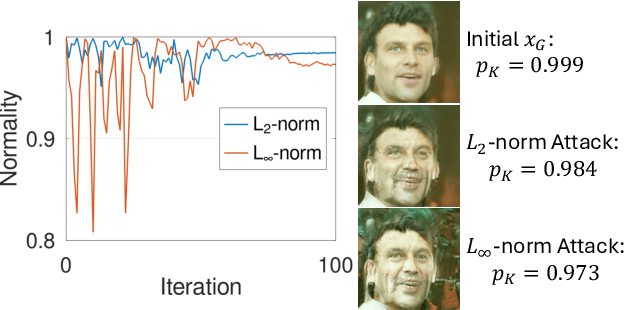
Abstract:Facial recognition technology poses significant privacy risks, as it relies on biometric data that is inherently sensitive and immutable if compromised. To mitigate these concerns, face recognition systems convert raw images into embeddings, traditionally considered privacy-preserving. However, model inversion attacks pose a significant privacy threat by reconstructing these private facial images, making them a crucial tool for evaluating the privacy risks of face recognition systems. Existing methods usually require training individual generators for each target model, a computationally expensive process. In this paper, we propose DiffUMI, a training-free diffusion-driven universal model inversion attack for face recognition systems. DiffUMI is the first approach to apply a diffusion model for unconditional image generation in model inversion. Unlike other methods, DiffUMI is universal, eliminating the need for training target-specific generators. It operates within a fixed framework and pretrained diffusion model while seamlessly adapting to diverse target identities and models. DiffUMI breaches privacy-preserving face recognition systems with state-of-the-art success, demonstrating that an unconditional diffusion model, coupled with optimized adversarial search, enables efficient and high-fidelity facial reconstruction. Additionally, we introduce a novel application of out-of-domain detection (OODD), marking the first use of model inversion to distinguish non-face inputs from face inputs based solely on embeddings.
The Chronicles of Foundation AI for Forensics of Multi-Agent Provenance
Apr 17, 2025Abstract:Provenance is the chronology of things, resonating with the fundamental pursuit to uncover origins, trace connections, and situate entities within the flow of space and time. As artificial intelligence advances towards autonomous agents capable of interactive collaboration on complex tasks, the provenance of generated content becomes entangled in the interplay of collective creation, where contributions are continuously revised, extended or overwritten. In a multi-agent generative chain, content undergoes successive transformations, often leaving little, if any, trace of prior contributions. In this study, we investigates the problem of tracking multi-agent provenance across the temporal dimension of generation. We propose a chronological system for post hoc attribution of generative history from content alone, without reliance on internal memory states or external meta-information. At its core lies the notion of symbolic chronicles, representing signed and time-stamped records, in a form analogous to the chain of custody in forensic science. The system operates through a feedback loop, whereby each generative timestep updates the chronicle of prior interactions and synchronises it with the synthetic content in the very act of generation. This research seeks to develop an accountable form of collaborative artificial intelligence within evolving cyber ecosystems.
AnimeDL-2M: Million-Scale AI-Generated Anime Image Detection and Localization in Diffusion Era
Apr 15, 2025



Abstract:Recent advances in image generation, particularly diffusion models, have significantly lowered the barrier for creating sophisticated forgeries, making image manipulation detection and localization (IMDL) increasingly challenging. While prior work in IMDL has focused largely on natural images, the anime domain remains underexplored-despite its growing vulnerability to AI-generated forgeries. Misrepresentations of AI-generated images as hand-drawn artwork, copyright violations, and inappropriate content modifications pose serious threats to the anime community and industry. To address this gap, we propose AnimeDL-2M, the first large-scale benchmark for anime IMDL with comprehensive annotations. It comprises over two million images including real, partially manipulated, and fully AI-generated samples. Experiments indicate that models trained on existing IMDL datasets of natural images perform poorly when applied to anime images, highlighting a clear domain gap between anime and natural images. To better handle IMDL tasks in anime domain, we further propose AniXplore, a novel model tailored to the visual characteristics of anime imagery. Extensive evaluations demonstrate that AniXplore achieves superior performance compared to existing methods. Dataset and code can be found in https://flytweety.github.io/AnimeDL2M/.
Steganography Beyond Space-Time With Chain of Multimodal AI Agents
Feb 25, 2025Abstract:Steganography is the art and science of covert writing, with a broad range of applications interwoven within the realm of cybersecurity. As artificial intelligence continues to evolve, its ability to synthesise realistic content emerges as a threat in the hands of cybercriminals who seek to manipulate and misrepresent the truth. Such synthetic content introduces a non-trivial risk of overwriting the subtle changes made for the purpose of steganography. When the signals in both the spatial and temporal domains are vulnerable to unforeseen overwriting, it calls for reflection on what can remain invariant after all. This study proposes a paradigm in steganography for audiovisual media, where messages are concealed beyond both spatial and temporal domains. A chain of multimodal agents is developed to deconstruct audiovisual content into a cover text, embed a message within the linguistic domain, and then reconstruct the audiovisual content through synchronising both aural and visual modalities with the resultant stego text. The message is encoded by biasing the word sampling process of a language generation model and decoded by analysing the probability distribution of word choices. The accuracy of message transmission is evaluated under both zero-bit and multi-bit capacity settings. Fidelity is assessed through both biometric and semantic similarities, capturing the identities of the recorded face and voice, as well as the core ideas conveyed through the media. Secrecy is examined through statistical comparisons between cover and stego texts. Robustness is tested across various scenarios, including audiovisual compression, face-swapping, voice-cloning and their combinations.
Exploring Active Data Selection Strategies for Continuous Training in Deepfake Detection
Feb 11, 2025Abstract:In deepfake detection, it is essential to maintain high performance by adjusting the parameters of the detector as new deepfake methods emerge. In this paper, we propose a method to automatically and actively select the small amount of additional data required for the continuous training of deepfake detection models in situations where deepfake detection models are regularly updated. The proposed method automatically selects new training data from a \textit{redundant} pool set containing a large number of images generated by new deepfake methods and real images, using the confidence score of the deepfake detection model as a metric. Experimental results show that the deepfake detection model, continuously trained with a small amount of additional data automatically selected and added to the original training set, significantly and efficiently improved the detection performance, achieving an EER of 2.5% with only 15% of the amount of data in the pool set.
Zero-Shot Warning Generation for Misinformative Multimodal Content
Feb 02, 2025



Abstract:The widespread prevalence of misinformation poses significant societal concerns. Out-of-context misinformation, where authentic images are paired with false text, is particularly deceptive and easily misleads audiences. Most existing detection methods primarily evaluate image-text consistency but often lack sufficient explanations, which are essential for effectively debunking misinformation. We present a model that detects multimodal misinformation through cross-modality consistency checks, requiring minimal training time. Additionally, we propose a lightweight model that achieves competitive performance using only one-third of the parameters. We also introduce a dual-purpose zero-shot learning task for generating contextualized warnings, enabling automated debunking and enhancing user comprehension. Qualitative and human evaluations of the generated warnings highlight both the potential and limitations of our approach.
Imitation Game for Adversarial Disillusion with Multimodal Generative Chain-of-Thought Role-Play
Jan 31, 2025



Abstract:As the cornerstone of artificial intelligence, machine perception confronts a fundamental threat posed by adversarial illusions. These adversarial attacks manifest in two primary forms: deductive illusion, where specific stimuli are crafted based on the victim model's general decision logic, and inductive illusion, where the victim model's general decision logic is shaped by specific stimuli. The former exploits the model's decision boundaries to create a stimulus that, when applied, interferes with its decision-making process. The latter reinforces a conditioned reflex in the model, embedding a backdoor during its learning phase that, when triggered by a stimulus, causes aberrant behaviours. The multifaceted nature of adversarial illusions calls for a unified defence framework, addressing vulnerabilities across various forms of attack. In this study, we propose a disillusion paradigm based on the concept of an imitation game. At the heart of the imitation game lies a multimodal generative agent, steered by chain-of-thought reasoning, which observes, internalises and reconstructs the semantic essence of a sample, liberated from the classic pursuit of reversing the sample to its original state. As a proof of concept, we conduct experimental simulations using a multimodal generative dialogue agent and evaluates the methodology under a variety of attack scenarios.
GreedyPixel: Fine-Grained Black-Box Adversarial Attack Via Greedy Algorithm
Jan 24, 2025Abstract:A critical requirement for deep learning models is ensuring their robustness against adversarial attacks. These attacks commonly introduce noticeable perturbations, compromising the visual fidelity of adversarial examples. Another key challenge is that while white-box algorithms can generate effective adversarial perturbations, they require access to the model gradients, limiting their practicality in many real-world scenarios. Existing attack mechanisms struggle to achieve similar efficacy without access to these gradients. In this paper, we introduce GreedyPixel, a novel pixel-wise greedy algorithm designed to generate high-quality adversarial examples using only query-based feedback from the target model. GreedyPixel improves computational efficiency in what is typically a brute-force process by perturbing individual pixels in sequence, guided by a pixel-wise priority map. This priority map is constructed by ranking gradients obtained from a surrogate model, providing a structured path for perturbation. Our results demonstrate that GreedyPixel achieves attack success rates comparable to white-box methods without the need for gradient information, and surpasses existing algorithms in black-box settings, offering higher success rates, reduced computational time, and imperceptible perturbations. These findings underscore the advantages of GreedyPixel in terms of attack efficacy, time efficiency, and visual quality.
Cyber-Physical Steganography in Robotic Motion Control
Jan 08, 2025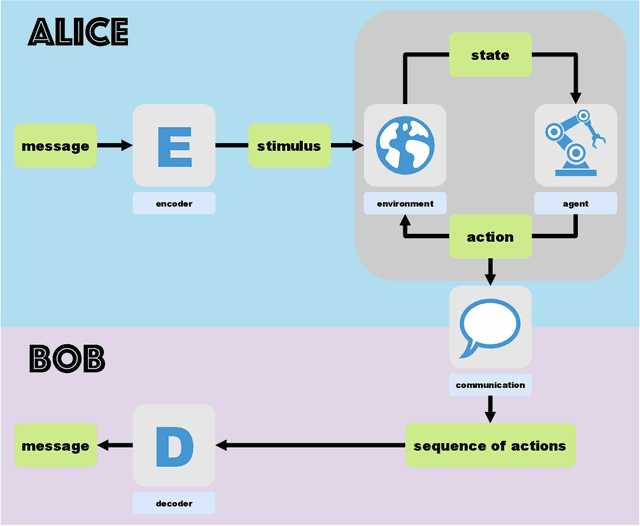
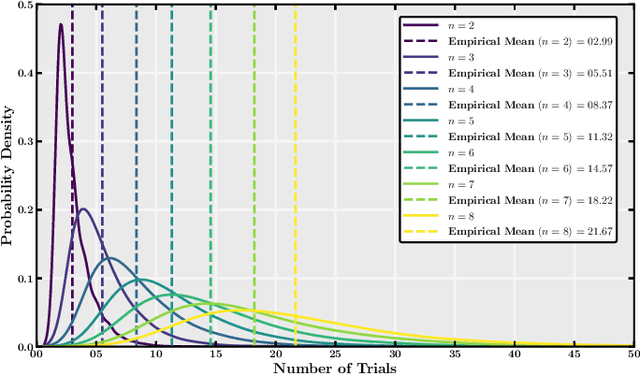
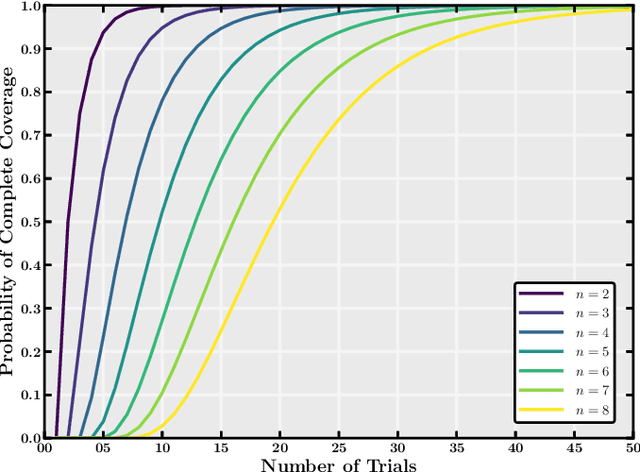
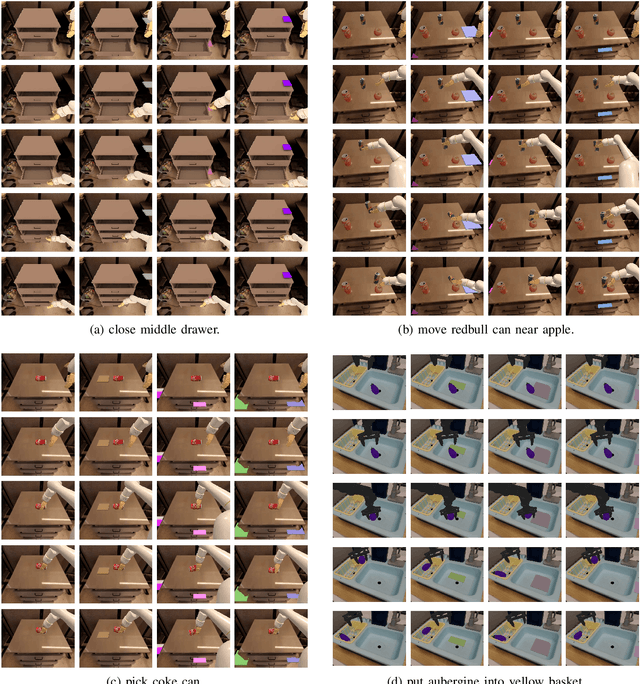
Abstract:Steganography, the art of information hiding, has continually evolved across visual, auditory and linguistic domains, adapting to the ceaseless interplay between steganographic concealment and steganalytic revelation. This study seeks to extend the horizons of what constitutes a viable steganographic medium by introducing a steganographic paradigm in robotic motion control. Based on the observation of the robot's inherent sensitivity to changes in its environment, we propose a methodology to encode messages as environmental stimuli influencing the motions of the robotic agent and to decode messages from the resulting motion trajectory. The constraints of maximal robot integrity and minimal motion deviation are established as fundamental principles underlying secrecy. As a proof of concept, we conduct experiments in simulated environments across various manipulation tasks, incorporating robotic embodiments equipped with generalist multimodal policies.
 Add to Chrome
Add to Chrome Add to Firefox
Add to Firefox Add to Edge
Add to Edge